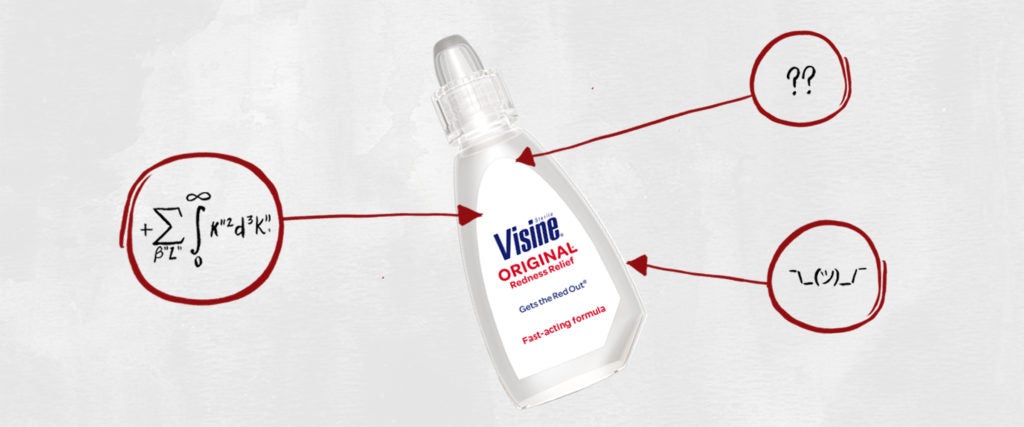We’re often told that you should never eat anything (or put anything on your body) if you don’t recognize everything on the ingredients list. But since most of us have no idea what xanthan gum or potassium benzoate are — or more importantly, what they’re doing to our bodies — we’re decoding the ingredients in the many things Americans put in (and on, or near) themselves.
This edition: Visine Original Redness Relief eye drops, which are made from seven separate ingredients that we’ve broken down in the exact order they appear on their website.

The Ingredients
1) Tetrahydrozoline HCL: The only active ingredient in these eye drops, tetrahydrozoline HCL reduces redness by binding to and activating alpha-adrenergic receptors in the eyes, which play an important role in the regulation of blood pressure. Or in less science-y terms, tetrahydrozoline HCL causes the superficial blood vessels in our eyes to constrict, which reduces blood flow, which in turn momentarily reduces redness and inflammation.
While tetrahydrozoline HCL helps in the short-term, prolonged use can result in an unfortunate ailment called rebound hyperemia, where the blood vessels in your eyes become permanently enlarged, resulting in even more redness for longer periods of time. In essence, your eyes can develop a tolerance to and become addicted to these eye drops.
Another potential concern about tetrahydrozoline HCL is that it can be poisonous and deadly if consumed orally. In 2018, a woman confessed to the slaying of her husband after an autopsy found toxic amounts of tetrahydrozoline HCL in his body. She later admitted to putting eye drops in his drinking water for three days before his death.
The lesson here: Definitely don’t drink eye drops (and maybe pour your own drinking water, too).
2) Benzalkonium Chloride: Benzalkonium chloride is a preservative found in most eye drops that works by killing roaming, potentially irritating microorganisms. While many studies have found it to be completely safe, at least one discovered that it might contribute to ocular surface disease. Either way, you probably only need to worry about that if you already have eye problems.
3) Boric Acid: Boric acid has some mild antifungal and antibacterial properties, which prevent these eye drops from spoiling while they live in your medicine cabinet. It may also help cleanse and irrigate the eyes by removing pollutants like smog, chlorine and other unpleasant chemicals.
4) Edetate Disodium: Edetate disodium functions primarily as a chelating agent, a substance that prevents deterioration and mold growth during processing and storage by binding the minerals within the product. Or in simpler terms, it keeps your eye drops working properly for a good while.
5) Purified Water: This simply serves as a pure base for the other ingredients.
6) Sodium Borate: Similar to boric acid, sodium borate prevents bacterial growth by controlling the pH of these eye drops, which is important considering you drop them in your literal eyes.
7) Sodium Chloride: Sodium chloride is just a fancy chemical name for salt. In these eye drops, it draws excess fluid out of the cornea to reduce swelling and potentially alleviate blurry vision.
The Takeaway
Because tetrahydrozoline HCL is a short-term fix for a long-term problem — and because it can contribute to more problems in the long run — ophthalmologists generally recommend simple lubricating drops (also known as artificial tears), as opposed to those that provide redness relief. That said, the occasional use of redness-reducing eye drops after smoking a pound of weed in the car before work is still fine and good.

